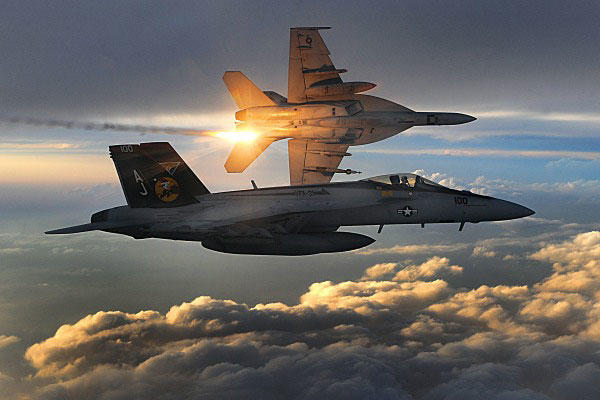Congress has authorized more funding to pay for next generation ballistic missile submarines, F/A-18 Super Hornets, new amphibious assault ships, Tomahawk missiles and Littoral Combat Ships in several House Armed Services markups of the proposed 2016 defense budget.
The House Armed Services Committee Seapower and Projection Forces subcommittee also emphasized that the Navy's developmental carrier launched drone, the Unmanned Carrier Launched Airborne Surveillance and Strike system, or UCLASS, needs to be a long-range penetrating strike drone.
Rep. Randy Forbes, the subcommittee chairman, has said the new carrier launched drone should be configured with stealth technology to penetrate enemy air defenses and be engineered to carry and deliver a weapons payload.
The planned competition to build the drone has been postponed as Pentagon decision makers deliberate requirements for the platform.
"I've been wanting for some time to make sure we have a deep penetrating strike capability. It is vitally important that we get this right and not just settle for an ISR capability. The key thing is we've got to be very careful about taking things off the table at the beginning because our potential adversaries or competitors are not going to take things off the table," Forbes said.
Overall, Forbes said the proposed budget bill represents the work Congress has done to remain committed to the U.S. military.
"From unmanned carrier aviation, to critical Air Force strike and airlift programs, to investment in Marine Corps amphibious programs, to the next-generation undersea nuclear deterrent, this year's mark will help sustain America's power projection capabilities in the years ahead," he said in a statement.
Ohio Replacement Submarine
Forbes' subcommittee adds $1.9 billion in research and development funds into a special account established to pay for the Navy's Ohio Replacement Program ballistic missile submarine – the National Sea-Based Deterrent Fund.
Established by Congress in legislation this year, the fund is designed to house money for the expensive nuclear submarine program by separating it from the Navy's formal shipbuilding budget.
The rationale for the fund is based on the need for topline budget relief to fund the undersea nuclear deterrence technology without massively reducing funds for the Navy's other shipbuilding programmatic efforts. Congressional sources say the money comes from Navy research and development, or R&D, accounts.
Related Video
Amphibs
The mark-up adds $279 million for advanced procurement materials for the Navy's new amphib, the LXR. The new ship, slated to be built by 2026, is the first in a series of new amphibs designed to replace the Navy's existing fleet of 41/49 Dock Landing Ships.
Based upon an LPD 17 Amphibious Transport Dock hull, it will be engineered with the command and control technology and aviation ability to conduct operations independently from an Amphibious Ready Group as needed.
Forbes said he was hoping to help accelerate development for the LXR.
"We need to increase the amount of funding we have and I am optimistic that we will be able to move forward with another LXR, probably this year," he told Military.com.
The subcommittee's mark up also authorizes funding for the Navy to complete its twelfth LPD 17 amphibious assault ship, called LPD 28. The mark-up also secures funding for a fifth Afloat Forward Staging Base or AFSB.
Carriers
The Seapower mark provides support for what's called mid-life refueling and complex overhaul, or RCOH, for its fleet of Nimitz-class aircraft carriers.
Designed to refuel carriers nuclear power and perform a series of maintenance and technology improvements, the RCOH is a four to six year mid-career stopping point in the 50-year life-s pan of an aircraft carrier.
Furthermore, providing dollars to refuel the USS George Washington, or CVN 73, will ensure the Navy maintains an 11-carrier fleet. The markup also begins procurement authority for the Navy to begin ordering components for several of the services' future Ford-class carriers – CVN80 and CVN 81.
Related Video
Littoral Combat Ship
The subcommittee provided funding for the procurement of three new Littoral Combat Ships, a series of lightly-armored multi-mission surface ships in development by the Navy.
Overall, the Navy plans to acquire as many as 52 of the vessels, with the last 20 or more designated as Frigates with greater levels of weaponry and protection.
Related Video
Tomahawk Missiles
The Navy will receive funding to increase their Tomahawk missile arsenal to 198 missiles – the minimum rate required to sustain the production line – under the proposed bill.
The Navy's inventory of Tomahawk missiles is slated to begin recertification by 2018 and 2019 in order to ensure the missiles can reach their full expected service life of about 30-years. At the same time, the Navy is currently considering a host of high-tech upgrades and improvements to the weapon designed to improve its ability to strike moving targets.
F-18s
HASCs Tactical Air and Land subcommittee added language in the mark-up indicating support for funding to pay for the 12 F/A-18 Super Hornets placed by the Navy on the unfunded requirements list.
Navy leaders have emphasized that more Super Hornet are needed to maintain the requisite fleet size due to maintenance backlogs, a high operational tempo and delays with the planned procurement of the Navy's carrier-launched F-35C.
Related Video
-- Kris Osborn can be reached at kris.osborn@military.com



























